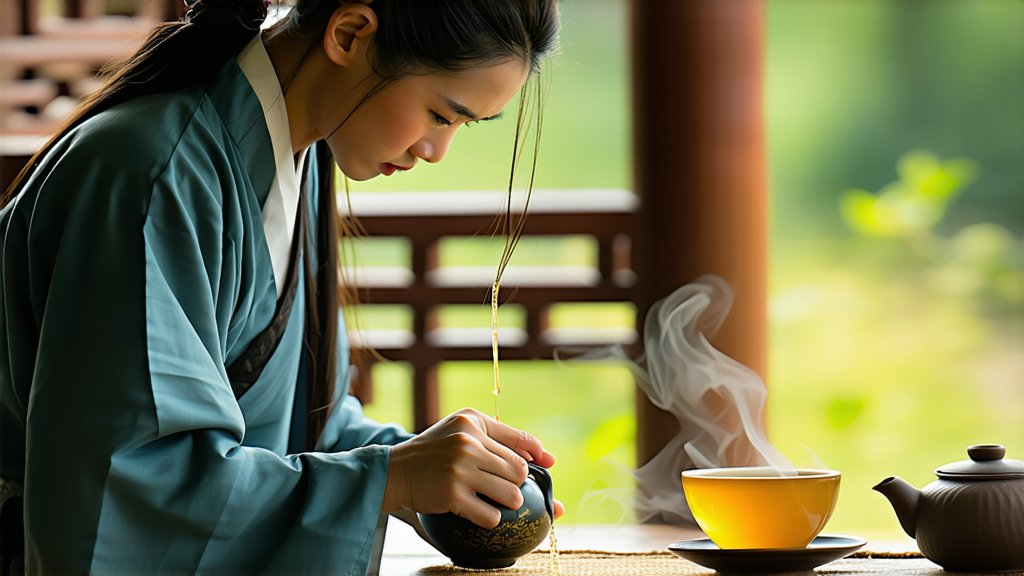
In the vast and diverse world of Chinese tea, few varieties capture the imagination and intrigue quite like Huoshao yellow tea. This exquisite brew, with its unique production process and delicate flavor profile, stands as a testament to the ingenuity and artistry inherent in Chinese tea culture. For international readers seeking to delve into the depths of this golden elixir, this article serves as a comprehensive guide, exploring the history, varieties, manufacturing techniques, and nuanced art of appreciating Huoshao yellow tea.
A Brief History
The origins of Huoshao yellow tea can be traced back to ancient China, where it emerged as a distinctive category within the broader spectrum of Chinese teas. Its development was closely tied to technological advancements in tea processing during the Ming Dynasty (1368–1644). Unlike green or black tea, which undergoes either minimal oxidation or full fermentation, yellow tea is partially oxidized, giving it a unique flavor and aromatic profile that sets it apart.
Huoshao, meaning "fire roasted," refers specifically to a sub-category of yellow tea that undergoes an additional roasting step. This method not only enhances the tea's flavor but also imparts a subtle smokiness that adds complexity to its character. The practice of fire roasting has roots in ancient Chinese tea-making traditions, where it was believed to improve the longevity and stability of the tea.
Varieties of Huoshao Yellow Tea
While there are various types of yellow tea in China, Huoshao yellow tea is one of the most revered. The most notable varieties include:
-
Junshan Yinzhen: Often referred to as "Silver Needle" due to its slender, needle-like leaves, Junshan Yinzhen is a premium variety hailing from Junshan Island in Hunan Province. It is prized for its bright, clear broth and sweet, mellow flavor.
-
Mengding Huangya: Produced in Mengding Mountain, Sichuan Province, Mengding Huangya features tightly rolled leaves with a golden hue. It offers a rich, full-bodied taste with notes of floral sweetness and a hint of roast.
-
Houpo Huangcha: Named after Houpo Township in Fujian Province, this variety is known for its robust, earthy flavors and deep amber color. The roasting process accentuates its natural sweetness and adds a layer of complexity.
Each of these varieties brings something unique to the table, offering a range of flavor profiles that cater to different palates and preferences.
The Art of Crafting Huoshao Yellow Tea
The production of Huoshao yellow tea involves several intricate steps, each requiring precision and skill. Here’s an overview of the process:
-
Plucking: High-quality Huoshao yellow tea begins with the careful plucking of young tea shoots and leaves. Typically, only the top two or three leaves and the bud are selected to ensure tenderness and optimal flavor.
-
Withering: After plucking, the leaves are spread out to wither under controlled conditions. This step helps reduce moisture content and initiates partial oxidation. The leaves are gently stirred to prevent them from sticking together.
-
Fixing: Once withered, the leaves undergo a fixing process to halt further oxidation. This is usually done through steaming or pan-frying. Steaming preserves more of the tea’s natural flavors, while pan-frying imparts a slightly toasty note.
-
Roasting: The defining feature of Huoshao yellow tea is the roasting step. The fixed leaves are spread thinly on bamboo trays and roasted over charcoal fires. This process requires constant attention to avoid burning the leaves while ensuring they acquire a pleasant smoky aroma.
-
Rolling and Drying: After roasting, the leaves are rolled to shape them and then dried to achieve the desired level of dryness. This final drying step ensures the tea can be stored without spoilage.
The Nuanced Art of Tasting Huoshao Yellow Tea
Tasting Huoshao yellow tea is both an art and a science, requiring a keen sense of observation and an appreciation for subtle flavors. Here’s how you can fully appreciate this unique beverage:
-
Preparation: Use freshly drawn, cold water and heat it to about 80-85°C (176-185°F). Avoid boiling water as it can scald the delicate leaves. Place 2-3 grams of Huoshao yellow tea per 150 ml of water in a clean, odor-free Gaiwan or teapot.
-
Infusion: Steep the tea for 2-3 minutes. Observe the unfurling leaves and the color of the liquor. A well-crafted Huoshao yellow tea will produce a bright, amber-colored infusion with a fragrant aroma.
-
Aroma: Before taking your first sip, bring the cup close to your nose and inhale deeply. Notice the complex bouquet—a blend of floral sweetness, vegetal freshness, and a subtle smokiness from the roasting process.
-
Flavor: Take a slow, deliberate sip, allowing the tea to coat your entire palate. Pay attention to the initial burst of flavor, the mid-notes, and the lingering finish. Huoshao yellow tea typically offers a balanced profile with sweet, mellow notes and a hint of smokiness.
-
Mouthfeel: Assess the texture of the tea in your mouth. A good Huoshao yellow tea should feel smooth and velvety, with a slight viscosity that indicates its high quality.
-
Aftertaste: Note the aftertaste left on your palate after swallowing. A superior Huoshao yellow tea will leave a pleasant, lasting sweetness and a gentle warmth from the roasting process.
Conclusion
Huoshao yellow tea represents a pinnacle of achievement in Chinese tea craftsmanship, blending tradition with innovation to create a beverage that is as complex as it is delightful. From its storied history to its meticulous production process and refined tasting experience, Huoshao yellow tea offers a window into the soul of Chinese tea culture. Whether you are a seasoned connoisseur or a curious newcomer, this golden secret promises an unforgettable journey for your senses.
For those eager to explore this remarkable tea, seeking out authentic Huoshao yellow tea from reputable sources is essential. Enjoy it slowly, savor each sip, and let yourself be transported to the misty mountains of China where this extraordinary tea was born.